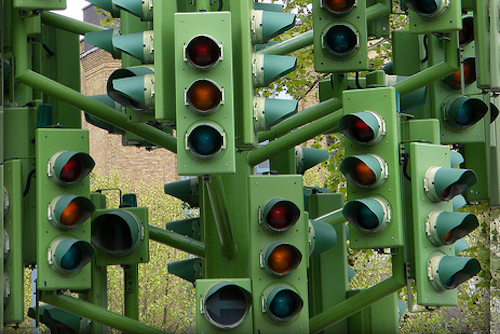
Among the victors emerging from Tuesday’s midterm elections was digital news. On sites’ homepages and politics sections across the web, interactive features, data-rich graphics, and live-streaming came into their own, offering users a live alternative to TV returns-watching that was even more impressive and immersive than it had been in 2008. But, for those sites, did the increased quality of coverage lead to increased traffic? To find out, we on the Lab staff have done a (highly unscientific) survey of traffic stats from some of the major outlets covering Tuesday’s returns.
Since different news organizations measure traffic differently — and have different policies on what they consider shareable and what they consider top secret — the numbers aren’t directly comparable. But they should give some sense of the shape of audience response. If you have access to stats for a site not on our list, share them in the comments.
NPR: According to NPR media relations manager Anna Christopher Bross, pageviews for NPR.org were up overall on election night, getting a 23 percent bump from normal Tuesday-night traffic. At the same time, election night brought an 11 percent increase in the use of NPR’s iPhone app and an 83-percent jump in traffic on the NPR mobile site, which featured live returns similar to those on the normal site. The requests for streaming audio broadcasts, meanwhile, were double those for a typical day.
The New York Times: While the Times doesn’t generally release its specific traffic stats, the paper did see, as you’d expect, a big spike in traffic to its online Politics section: Over Tuesday and Wednesday, the section accounted for 21 percent of total site pageviews, Kristin Mason, the Times’ communications manager, told us in an email. And NYTimes.com, with its powerful graphics, interactive features, straight-from-the-newsroom video streams, personality-driven live blogs, and Twitter integration, became a destination for election coverage, rather than just a stopping point: Nearly half the traffic to the Politics section, Mason noted, came from within the site itself. Tuesday and Wednesday “each earned a spot on the list of the top 5 busiest days for the NYTimes homepage” ever.
The Wall Street Journal: For its overnight (7 p.m. to 2 a.m.) traffic, when the outlet offered the bulk of its online coverage, WSJ.com saw a 50 percent increase in its pageviews over the typical Tuesday, Ashley Huston, Dow Jones’ senior director of communications, told us. (Between 7 p.m and 9 p.m., it saw a 40 percent increase.) And the outlet’s video-based coverage, for its part, garnered 300,000 views.
The Chicago Tribune: The paper’s Election Center got more than 1 million pageviews on election day, a 25 percent increase over the numbers for the primary, according to Ben Estes, editor of ChicagoTribune.com. Overall traffic to the site was up 40 percent over a normal weekday, with the biggest surge coming between 10 p.m. and 11 p.m.
The Los Angeles Times: Latimes.com traffic tripled from the average number of visitors on election night, Tribune Company communication VP Nancy Sullivan told us in an email. “With California’s hotly contested races, these numbers met expectations and all online operations ran smoothly,” she noted. As expected, as well, “election data traffic was most substantial to pages on Western states, leading with California and followed by Alaska, Nevada, Colorado and Washington.”
Talking Points Memo: Editor and publisher Josh Marshall told us in an email that his election night strategy “to go head to head with other major media sites” took significant investment — and paid off. TPM’s homepage hosted an interactive map and election scoreboard, built in-house, that let readers monitor results as they came in throughout the night.
The site was noticeably stable, considering the bells and whistles and TPM’s smaller size. The site’s “increasing move toward cloud computing for our server needs which both provides critical savings but much more importantly the ability to scale capacity much more fluidly and rapidly than with the traditional boxes in a closet approach.” As far as traffic, TPM looked at the statistics from election night 2006 and 2008 to determine what they might see in 2010. And “the results were substantially higher than we expected,” Marshall said.
Compared to a typical Tuesday, TPM’s election night saw a 220 percent increase for unique viewers, and a 290 percent increase for overall pageviews. And those who came stuck around: the outlet’s time-on-site states jumped by 206 percent.
Real Clear Politics: Chief Technology Officer Anand Ramanujan told us that Real Clear Politics, an all-things-politics site that specializes in polling data, had four times the traffic on election night that it has on a typical Tuesday. Unique visits were up by 500 percent. With that, the site met its expectations for the night. “The numbers were in line with our expectations,” Ramanujan wrote in an email. Like TPM, they also prepared for the influx. “We added additional servers in preparation for election night and our infrastructure was able to handle this spike.”
Image by UggBoy[hearts]UggGirl used under a Creative Commons license.